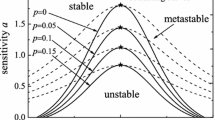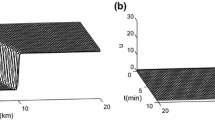Abstract
A new car-following model termed as multiple headway, velocity, and acceleration difference (MHVAD) is proposed to describe the traffic phenomenon, which is a further extension of the existing model of full velocity difference (FVD) and full velocity and acceleration difference (FVAD). Based on the stability analysis, it is shown that the critical value of the sensitivity in the MHVAD model decreases and the stable region is apparently enlarged, compared with the FVD model and other previous models. At the end, the simulation results demonstrate that the dynamic performance of the proposed MHVAD model is better than that of the FVD and FVAD models.
Similar content being viewed by others
References
Sandra, U.N., Christian, P., Roberto, W.C.: An effective memetic algorithm for the cumulative capacitated vehicle routing problem. Comput. Oper. Res. 37, 1877–1885 (2010)
Zhang, H.Z., Cesar, B.R., Miguel, C.: Effective formulation reductions for the quadratic assignment problem. Comput. Oper. Res. 37, 2007–2016 (2010)
Zhao, X.M., Gao, Z.Y.: Controlling traffic jams by a feedback signal. Eur. Phys. J. B 43, 565–572 (2005)
David, J.L., Paul, S.A.: A nonlinear temporal headway model of traffic dynamics. Nonlinear Dyn. 16, 127–151 (1998)
Xu, N., Shang, P., Kamae, S.: Modeling traffic flow correlation using DFA and DCCA. Nonlinear Dyn. 61, 207–216 (2010)
Weng, Y.L., Wu, T.J.: Car-following model for vehicular traffic. J. Zhejiang Univ. Sci. 3(4), 412–417 (2002)
Bando, M., Hasebe, K., Nakayama, A., Shibata, A., Sugiyama, Y.: Dynamics model of traffic congestion and numerical simulation. Phys. Rev. E, Stat. Nonlinear Soft Matter Phys. l(51), 1035–1042 (1995)
Helbing, D., Tilch, B.: Generalized force model of traffic dynamics. Phys. Rev. E, Stat. Nonlinear Soft Matter Phys. 58, 133–138 (1998)
Treiber, M., Hennecke, A.: Helbing D. Derivation, properties and simulation of a gas-kinetic-based nonlocal traffic model. Phys. Rev. E, Stat. Nonlinear Soft Matter Phys. 59, 239–253 (1999)
Jiang, R., Wu, Q.S., Zhu, Z.J.: Full velocity difference model for a car-following theory. Phys. Rev. E, Stat. Nonlinear Soft Matter Phys. 64, 017101–017105 (2001)
Jiang, R., Wu, Q.S., Zhu, Z.J.: A new continuum model for traffic flow and numerical tests. Transp. Res., Part B, Methodol. 36, 405–419 (2002)
Zhao, X.M., Gao, Z.Y.: A new car-following model: full velocity and acceleration difference model. Eur. Phys. J. B 47, 145–150 (2005)
Zhao, X.M., Gao, Z.Y.: The stability analysis of the full velocity and acceleration difference model. Physica A 375, 679–686 (2007)
Ge H, X., Dai, S.Q., Dong, L.Y., Xue, Y.: Stabilization effect of traffic flow in an extended car-following model based on an intelligent transportation system application. Phys. Rev. E, Stat. Nonlinear Soft Matter Phys. 70, 066134–066140 (2004)
Wang, T., Gao, Z.Y., Zhao, X.M. Multiple velocity difference model and its stability analysis. Acta Phys. Sin. 55, 634–638 (2006)
Peng, G.H., Sun, D.H.: Multiple car-following model of traffic flow and numerical simulation. Chin. Phys. B 18(12), 5420–5430 (2009)
Peng, G.H.: Stabilization analysis of multiple car-following model in traffic flow. Chin. Phys. B 19(5), 056401–056409 (2010)
Xie, D.F., Zhao, Z.Y., Gao, X: Stabilization of traffic flow based on the multiple information of preceding cars. Commun. Comput. Phys. 3(4), 899–912 (2008)
Sun, D.H., Li, Y.F., Tian, C.: Car-following model based on the information of multiple ahead & velocity difference. Syst. Eng. Theory Prac. 30(7), 1326–1332 (2010)
Zhang, H.M.: Analysis of the stability and wave properties of a new continuum traffic theory. Transp. Res., Part B, Methodol. 33, 399–415 (1999)
Tang, T.Q., Huang, H.J., Zhang, Y.: Stability analysis for traffic flow with perturbations. Int. J. Mod. Phys. C 19, 1367–1375 (2008)
Author information
Authors and Affiliations
Corresponding author
Additional information
An erratum to this article can be found at http://dx.doi.org/10.1007/s11071-011-0236-7
Rights and permissions
About this article
Cite this article
Li, Y., Sun, D., Liu, W. et al. Modeling and simulation for microscopic traffic flow based on multiple headway, velocity and acceleration difference. Nonlinear Dyn 66, 15–28 (2011). https://doi.org/10.1007/s11071-010-9907-z
Received:
Accepted:
Published:
Issue Date:
DOI: https://doi.org/10.1007/s11071-010-9907-z




